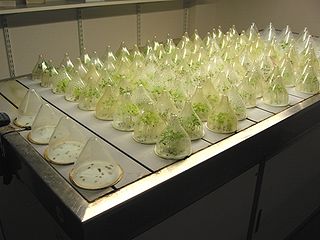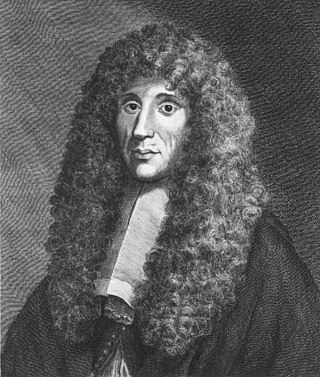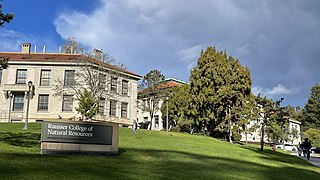Related Research Articles

Plant physiology is a subdiscipline of botany concerned with the functioning, or physiology, of plants.

Phytochromes are a class of photoreceptor proteins found in plants, bacteria and fungi. They respond to light in the red and far-red regions of the visible spectrum and can be classed as either Type I, which are activated by far-red light, or Type II that are activated by red light. Recent advances have suggested that phytochromes also act as temperature sensors, as warmer temperatures enhance their de-activation. All of these factors contribute to the plant's ability to germinate.
Christopher John Leaver is an Emeritus Professorial Fellow of St John's College, Oxford who served as Sibthorpian Professor in the Department of Plant Sciences at the University of Oxford from 1990 to 2007.
Spermine is a polyamine involved in cellular metabolism that is found in all eukaryotic cells. The precursor for synthesis of spermine is the amino acid ornithine. It is an essential growth factor in some bacteria as well. It is found as a polycation at physiological pH. Spermine is associated with nucleic acids and is thought to stabilize helical structure, particularly in viruses. It functions as an intracellular free radical scavenger to protect DNA from free radical attack. Spermine is the chemical primarily responsible for the characteristic odor of semen.

A biologist is a scientist who conducts research in biology. Biologists are interested in studying life on Earth, whether it is an individual cell, a multicellular organism, or a community of interacting populations. They usually specialize in a particular branch of biology and have a specific research focus.

The Rausser College of Natural Resources (RCNR), or Rausser College, is the oldest college at the University of California, Berkeley and in the University of California system. Established in 1868 as the College of Agriculture under the federal Morrill Land-Grant Acts, CNR is the first state-run agricultural experiment station. The college is home to four internationally top-ranked academic departments: Agriculture and Resource Economics; Environmental Science, Policy, and Management; Nutritional Sciences and Toxicology; and Plant and Microbial Biology, and one interdisciplinary program, Energy and Resources Group. Since February 2020, it is named after former dean and distinguished professor emeritus Gordon Rausser after his landmark $50 million naming gift to the college.
Vernon Ahmadjian was a distinguished professor at Clark University in Worcester, Massachusetts. He specialized in the symbiosis of lichens, and wrote several books and numerous publications on the subject.
The College of Biological Sciences (CBS) is one of seven freshman-admitting colleges at the University of Minnesota. Established in 1965, the College of Biological Sciences is located on both the Minneapolis and the St. Paul campuses. Faculty in the college conduct research on a wide range of topics that contribute to understanding of the environment, human health and basic biology. Dr. Saara J. DeWalt is the current dean of the college.

Trebouxia is a unicellular green alga. It is a photosynthetic organism that can exist in almost all habitats found in polar, tropical, and temperate regions. It can either exist in a symbiotic relationship with fungi in the form of lichen or it can survive independently as a free-living organism alone or in colonies. Trebouxia is the most common photobiont in extant lichens. It is a primary producer of marine, freshwater and terrestrial ecosystems. It uses carotenoids and chlorophyll a and b to harvest energy from the sun and provide nutrients to various animals and insects.

The College of Natural Science (NatSci) at Michigan State University is home to 27 departments and programs in the biological, physical and mathematical sciences.
Arthur W. Galston was an American plant physiologist and bioethicist. As a plant biologist, Galston studied plant hormones and the effects of light on plant development, particularly phototropism. He identified riboflavin and other flavins as what are called phototropins, photoreceptor proteins for phototropism, challenging the prevailing view that carotenoids were responsible.

Ruth Lyttle Satter was an American botanist best known for her work on circadian leaf movement.
Helen Marie Dyer was an American biochemist and cancer researcher. Her main work concerned the mechanism of carcinogenesis; she also worked with metabolism and nutrition.
Seymour Stanley Cohen was an American biochemist. Cohen was born in Brooklyn, New York in April 1917. He attended City College of New York and his PhD came from Columbia University under the supervision of Erwin Chargaff. In the 1940s he worked on plant viruses and for the Rockefeller Institute. He was awarded a Guggenheim Fellowship in 1945. He is known by his studies with marked of radioactive isotopes, whose results suggested an essential role of DNA in hereditary genetic material. This result would be checked in 1952 by Hershey and Chase.

Peter John Davies is a professor emeritus of Plant Physiology in the Departments of Plant Biology and Horticulture at Cornell University who is notable for his work on plant development, plant hormones, and in educating the public on agricultural technology and genetically modified organisms (GMOs) as a Jefferson Science Fellow from 2011 to 2014. As a Jefferson Science Fellow Davies monitored developments in agriculture and food security, monitored the status of biotech crops in Europe, and provided input to promote the acceptance of these crops on a scientific basis.
Perdur Radhakantha Adiga was an Indian endocrine biochemist, reproductive biologist, INSA Senior Scientist and an Astra chair professor of the Indian Institute of Science. He was known for his researches on vitamin-carrier proteins and Lathyrus sativus and was an elected fellow of the Indian Academy of Sciences and the Indian National Science Academy. The Council of Scientific and Industrial Research, the apex agency of the Government of India for scientific research, awarded him the Shanti Swarup Bhatnagar Prize for Science and Technology, one of the highest Indian science awards for his contributions to Medical Sciences in 1980.
George B. Delahunty is an American physiologist and endocrinologist. He was a long-time professor at Goucher College, working there from 1979 to 2018. Delahunty was the Lilian Welsh Professor of Biology and a co-founder of the post-baccalaureate premedical program at Goucher College. His research explored metabolism and endocrine control in vertebrates.
Beronda Montgomery is a writer, science communicator, and researcher. In 2022, she moved to Grinnell College as professor of biology and vice president for academic affairs and dean of the college. Prior to Grinnell, Montgomery served as Michigan State University Foundation Professor in the Departments of Biochemistry & Molecular Biology and of Microbiology & Molecular Genetics. She was also a member of the MSU-DOE Plant Research Laboratory. Her research group investigates how photosynthetic organisms adapt to changes in their environment. Her scholarship extends beyond biology and into studying mentorship and faculty development to develop evidence-based strategies to foster equity and inclusion in academia. Together with Tanisha Williams and other members of the Black Botanists Week organizing committee, Montgomery co-founded and co-organizes Black Botanists Week.
Doris Wagner is an American biologist who is the Robert I. Williams Term Professor of Biology at the University of Pennsylvania. Her research looks to better understand the structure-function relationships of plant cells. She established the Epigenomics of Plants International Consortium. Wagner is a Fellow of the American Society of Plant Biologists.
Trebouxia gelatinosa is a common symbiotic species of green alga in the family Trebouxiaceae. Formally described as new to science in 1975, it is usually found in association with different species of lichen-forming fungi.
References
- 1 2 "Goucher College 2013-2014 Undergraduate Catalogue". Goucher College.
- ↑ Slocum, Robert Dale (1977). Effects of SO₂ and pH on the ultrastructure of the Trebouxia phycobiont of the pollution-sensitive lichen Parmelia caperata (L.) Ach (Thesis). OCLC 3815640.
- ↑ Slocum, Robert Dale (1981). Studies on the localization of phytochrome and calcium in light-and-gravity-stimulated plants (Thesis). OCLC 8489965.
- ↑ "Robert Slocum". Goucher College. Retrieved May 10, 2018.
- ↑ Biochemistry and physiology of polyamines in plants. Slocum, Robert D., Flores, Hector E. Boca Raton: CRC Press. 1991. ISBN 0849368650. OCLC 24794433.
{{cite book}}: CS1 maint: others (link) - ↑ "Center for Natural Sciences Faculty". Goucher College. Retrieved May 10, 2018.
- ↑ "Robert D. Slocum". The Baltimore Sun. October 28, 2005. Retrieved May 10, 2018– via Newspapers.com.
- ↑ Slocum, Robert D.; Scholl, Jacob D. (Fall 2013). "NSF Support of Research at Primarily Undergraduate Institutions (PUIs)" (PDF). Council on Undergraduate Research Quarterly.